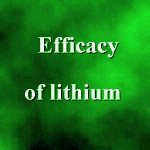Links
History of the Introduction of Lithium
In the test tube, lithium combines with uric acid to produce a soluble solution, seeming to raise the possibility of removing gouty nodules as well as preventing uric acid accumulation. Lithium was tried in the 19th century in the treatment of a large variety of disorders such as uraemia, renal calculi, gout and rheumaticism. Enthusiasm extended into proprietary medicines and led to the widespread use of bottled curative waters, many of which are still on the market eg. Vichy, Perrier, promoted at one time for their high lithium content.
During the late 1940s, evidence accumulated suggesting cardiac and hypertensive patients would benefit from a salt-free diet and lithium chloride seemed an ideal alternative to table salt. Medical reports appeared in 1949 describing severe poisonings and three deaths connected with lithium chloride and drug manufacturers voluntarily withdrew all lithium salts from the market.
Cade (1949) reasoned that mania was caused by a normal product of the body circulating in excess. He found that concentrated fresh urine of manic patients injected intraperitoneally into guinea pigs was often found to kill more readily than urine from normal persons, schizophrenics or melancholics. Urea was identified as the toxic substance and in trying to establish how much uric acid increased the toxicity of urea, lithium urate, as the most soluble urate, was injected with a urea solution into guinea pigs, seeming to produce a protective effect. To determine whether lithium salts by themselves had any discernible effects, lithium carbonate was injected and after a period of about two hours the animals, although fully conscious, became extremely lethargic and unresponsive to stimuli for a few hours before once again becoming normally active. As Cade himself admits "It may seem a long way from lethargy in guinea pigs to the control of manic excitement, but as these investigations had commenced in an attempt to demonstrate some possibly excreted toxin in the urine of manic patients, the association of ideas is explicable", even if totally fallacious. It can be conjectured that the docility of the guinea pigs was due to lithium toxicity. Not unusually in medicine, lithium was introduced through a mistaken hypothesis.
Cade J (1949) Lithium salts in the treatment of psychotic excitement. Med J Australia 36 349
Historical controversy about lithium
The Shepherd-Blackwell-Schou-Angst episode:-
Editorial (1969) Lithium Lancet 1 709
Blackwell B and Shepherd M (1968) Prophylactic lithium: Another theapeutic myth? Lancet 1 968
Angst J, Grof P and Schou M (1969) Lithium Lancet 1 1097
The Kline-Blackwell-Kline exchange
Kline NS (1968) Lithium comes of its own. American Journal of Psychiatry 125 558-60
Blackwell B (1969) Need for careful evaluation of lithium. American Journal of Psychiatry 125 1131
Kline NS (1969) Dr Kline replies. American Journal of Psychiatry 125 1131-2


